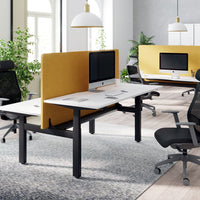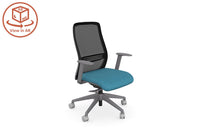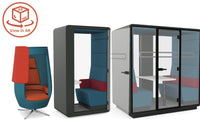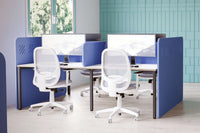Boost Your Productivity and Comfort: How to Choose the Best Office Chair for Your Needs
With so many options available in the market, finding the perfect office chair may seem overwhelming. That's why we have done the research for you and compiled a comprehensive guide to help you make an informed decision.
Whether you're working long hours at home or in a corporate office, the right office chair can significantly impact your well-being and work performance. We will explore important features to consider, such as ergonomics, adjustability, and lumbar support. We will also provide insights into different types of office chairs, including mesh chairs, leather chairs, and ergonomic kneeling chairs.
Stay tuned to discover the secrets to selecting the best office chair that suits your needs, enhances your productivity, and offers unparalleled comfort throughout your workday.
The importance of choosing the right office chair
How many hours do you sit down?
The most important question to ask yourself is how many hours a day you will be sitting in your chair. The more hours you sit down, the better chair you will need. In order to make it easy for you to find a chair that suits your needs, we divide the range into four recommended sitting times: 4, 8, 12 and 24 hours. That means we have everything from basic chairs for people who rarely sit down to more heavy-duty options that offer high levels of seating comfort during long working hours.
- 4 hours: If you are on the go most of the time and only sit down at your desk for short periods, you can do well with a relatively simple and inexpensive chair.
- 8 hours: The most common type of office chair. If you work an average length working day and spend most of it sitting down, you need an ergonomic chair with good adjustment possibilities.
- 12 hours: Do you work long shifts sitting down? Then you should choose a chair suitable for 12 or more hours of use that offers optimum support and the ability to adjust the seat to your body.
- 24 hours: If someone occupies the chair around the clock, such as in control rooms or call centres, then it needs to meet extremely high standards for adjustment and comfort – just like our certified 24 hour models.
Your office chair is more than just a piece of furniture. It is an essential tool that can significantly impact your well-being and work performance. A poorly designed chair can lead to discomfort, back pain, and even long-term health issues. On the other hand, a well-designed office chair can improve your posture, provide proper support, and enhance your overall productivity.
When you sit for extended periods, it's crucial to have a chair that promotes good posture and supports your body in all the right places. The right office chair can also reduce fatigue and improve blood circulation, allowing you to stay focused and energized throughout the day.
Factors to consider when selecting an office chair
Before diving into the features and types of office chairs, it's essential to consider your specific needs and work requirements. Here are some factors to keep in mind when choosing the perfect office chair:
1. Comfort: Look for a chair that provides adequate cushioning and support. Consider the materials used and the overall design to ensure maximum comfort during long hours of sitting.
2. Ergonomics: Ergonomics is the science of designing products to fit the user's needs. A good office chair should have adjustable features, such as seat height, armrests, and lumbar support, to accommodate different body types and preferences.

3. Durability: Invest in a chair that is built to last. Look for high-quality materials and sturdy construction to ensure your chair withstands daily use for years to come.
4. Style: While comfort and functionality are crucial, it's also essential to choose a chair that complements your workspace. Consider the aesthetics and design of the chair to create a cohesive and visually appealing office environment.
Ergonomic features to look for in an office chair
When it comes to ergonomics, there are several key features to look for in an office chair. These features are designed to provide optimal support and comfort, minimizing the risk of discomfort and long-term health issues. Here are some essential ergonomic features to consider:
1. Adjustable Seat Height: A chair with adjustable seat height allows you to customize the chair's height based on your desk and personal preference. Ideally, your feet should be flat on the floor, and your knees should form a 90-degree angle.
2. Lumbar Support: Proper lumbar support helps maintain the natural curve of your lower back, reducing strain and promoting good posture. Look for a chair with adjustable lumbar support or built-in lumbar padding.
3. Adjustable Armrests: Adjustable armrests allow you to position your arms comfortably while typing or using the computer. The armrests should be at a height that allows your shoulders to relax and your elbows to rest at a 90-degree angle.
4. Backrest Tilt and Lock: A chair with a tilting backrest allows you to recline and relax during breaks, reducing strain on your back. Look for a chair with a lock mechanism that allows you to secure the backrest in your preferred position.
5. Seat Depth Adjustment: Seat depth adjustment ensures that there is enough space between the edge of the seat and the back of your knees. This feature is especially important for taller individuals or those with longer legs.
6. Headrest: A headrest provides additional support for your neck and head, reducing strain and promoting proper alignment. Consider a chair with an adjustable or removable headrest for maximum comfort.
Different types of office chairs
Now that we have covered the important ergonomic features, let's explore the different types of office chairs available in the market. Each type of chair offers unique benefits and is designed to cater to specific needs. Here are some popular types of office chairs:
1. Mesh Chairs: Mesh chairs are known for their breathability and flexibility. The mesh fabric allows air circulation, reducing the build-up of heat and moisture. These chairs are suitable for individuals who prefer a lightweight and breathable option.
2. Leather Chairs: Leather chairs exude elegance and sophistication while providing comfort and durability. They are easy to clean and maintain, making them a popular choice for executive offices or home offices with a more luxurious aesthetic.
3. Ergonomic Kneeling Chairs: Kneeling chairs promote a more active sitting posture by positioning the body in a slightly forward-leaning position. These chairs distribute the weight between the buttocks and the knees, reducing strain on the lower back.
4. Ball Chairs: Ball chairs, also known as stability or exercise ball chairs, promote core strength and balance. These chairs feature a large exercise ball as the seat, which engages your core muscles while you sit. They are suitable for individuals who want to improve their posture and strengthen their core muscles.
How to determine the right size of an office chair
Choosing the right size of an office chair is crucial for optimal comfort and support. Here are some guidelines to help you determine the right size:
1. Seat Height: The seat height should allow your feet to rest flat on the floor, with your knees forming a 90-degree angle. Adjust the chair's height accordingly to achieve this position.
2. Seat Width and Depth: The seat should be wide and deep enough to provide ample support and allow you to sit comfortably. Aim for a seat width of at least 17-20 inches and a seat depth of 15-17 inches.
3. Backrest Height: The backrest height should support the natural curve of your spine, providing adequate lumbar support. Look for a chair with a backrest height that reaches at least the middle of your back.
4. Armrest Height: The armrests should be at a height that allows your shoulders to relax and your elbows to rest at a 90-degree angle. Adjustable armrests are ideal for achieving the perfect height.

Popular office chair brands and their features
There are numerous office chair brands available in the market, each offering a wide range of features and designs. Here are some popular brands known for their quality and ergonomic features:
1. Our Range of Edit office chairs are cost effective and well designed. With solutions for all shapes and sizes the solutions are availble ot view in 360 degree so you get to see chairs from every angle.
1. Herman Miller: Herman Miller is renowned for its innovative designs and ergonomic chairs. Their chairs feature adjustable lumbar support, advanced tilt mechanisms, and high-quality materials. However they cost.
2. Steelcase: Steelcase is known for its research-based design and commitment to ergonomics. Their chairs offer customisable features, such as adjustable armrests, lumbar support, and seat depth.
3. Humanscale: Humanscale focuses on designing chairs that provide intuitive and effortless comfort. Their chairs feature weight-sensitive recline, automatic lumbar support, and a minimalistic design.
4. IKEA: IKEA offers a range of affordable office chairs that combine comfort and functionality. Their chairs often feature adjustable seat height, lumbar support, and a variety of materials and styles to choose from.
Budget-friendly office chair options
If you're on a tight budget, there are still plenty of options available for finding a comfortable and ergonomic office chair. Here are some budget-friendly options to consider:
However avoid cheap chairs under £120 as he seat ases usually have limited foam support and they are designed for a price point rather than comfort and veryday use.
Remember a good quality chairs is the equiavlent cost of weekly cup of coffee!
Maintaining and caring for your office chair
Once you have found the perfect office chair, it's essential to properly maintain and care for it to ensure its longevity. Here are some tips for maintaining your office chair:
However avoid
1. Regular Cleaning: Clean your chair regularly to remove dust, dirt, and stains. Follow the manufacturer's cleaning instructions to avoid damaging the materials.
2. Check for Loose Screws: Periodically check for loose screws or any signs of wear and tear. Tighten any loose screws to ensure the chair remains stable and safe.
3. Avoid Excessive Weight: Avoid placing excessive weight on the chair, as it can lead to premature wear and damage.
4. Use Chair Mats: If you have a carpeted floor, consider using a chair mat to protect both the chair and the carpet from damage.
Choosing the best office chair for your needs is a decision that should not be taken lightly. By considering factors such as comfort, ergonomics, and durability, you can find a chair that not only enhances your productivity but also promotes your overall well-being. Whether you opt for a mesh chair, leather chair, or ergonomic kneeling chair, make sure it meets your specific requirements and provides the support your body needs. Invest in a chair that prioritizes your comfort, and you will reap the benefits of increased productivity and reduced discomfort throughout your workday.














0 comments